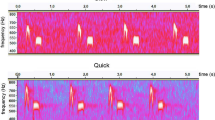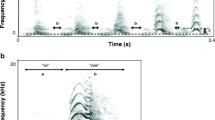Summary
The calls of male field crickets attract sexually receptive females. In Gryllus integer, males differ from one another in their durations of uninterrupted calling (calling bout lengths). Tape recordings of the calls of 50 wild-caught males revealed that 14 males spent most of their calling time in short bouts (Fig. 1A), 18 in both short and long bouts (Fig. 1B), and 18 in long bouts (Fig. 1C). Re-recordings of 32 males after 3 weeks showed that calling bout lengths of individual males are stable with time (age) (Fig. 2). Three phonotaxis experiments investigated whether calling bout lengths of males affect female preferences. They demonstrated that (1) females can discriminate among conspecific males on the basis of calls alone; (2) females are preferentially attracted to males with long calling bout lengths; and (3) calling bout length is the specific factor responsible for preferential attraction. These results precisely identify a criterion that females use to discriminate among potential mates of their own species.
Similar content being viewed by others
References
Alexander RD (1975) Natural selection and specialized chorusing behavior in acoustical insects. In: Pimentel D (ed) Insects, science and society. Academic Press, New York (pp 35–77)
Andersson M (1982) Female choice selects for extreme tail length in a widowbird. Nature 299:818–820
Arnold SJ (1985) Quantitative genetic models of sexual selection. Experientia 41:1296–1310
Boake CRB (1983) Mating systems and signals in crickets. In: Gwynne DT, Morris GK (eds) Orthopteran mating systems. Westview Press, Boulder (pp 28–44)
Boake CRB, Capranica RR (1982) Aggressive signal in “courtship” chirps of a gregarious cricket. Science 218:580–582
Bradbury JW, Gibson RM (1983) Leks and mate choice. In: Bateson P (ed) Mate choice. Cambridge University Press, Cambridge (pp 109–138)
Burk T (1983) Male aggression and female choice in a field cricket (Teleogryllus oceanicus): the importance of courtship song. In: Gwynne DT, Morris GK (eds) Orthopteran mating systems. Westview Press, Boulder (pp 97–119)
Cade WH (1981) Alternative male strategies: genetic differences in crickets. Science 212:563–564
Cade WH, Wyatt D (1984) Factors affecting calling behavior in field crickets, Teleogryllus and Gryllus (age, weight, density and parasites). Behaviour 88:61–75
Crankshaw OS (1979) Female choice in relation to calling and courtship songs in Acheta domesticus. Anim Behav 27:1274–1275
Darwin C (1871) The descent of man and selection in relation to sex. John Murray, London
Forrest TG (1983) Calling songs and mate choice in mole crickets. In: Gwynne DT, Morris GK (eds) Orthopteran mating systems. Westview Press, Boulder (pp 185–204)
Gerhardt HC (1982) Sound pattern recognition in some North American treefrops (Anura: Hylidae): Implications for mate choice. Am Zool 22:581–595
Gwynne DT (1983) Male nutritional investment and the evolution of sexual differences in Tettigoniidae and other Orthoptera. In: Gwynne DT, Morris GK (eds) Orthopteran mating systems. Westview Press, Boulder (pp 337–366)
Halliday TR (1983) The study of mate choice. In: Bateson P (ed) Mate choice. Cambridge University Press, Cambridge (pp 3–32)
Hamilton WD, Zuk M (1982) Heritable true fitness and bright birds: A role for parasites? Science 218:384–387
Hoy RR, Pollack GS, Moiseff A (1982) Species-recognition in the field cricket, Teleogryllus oceanicus: behavioral and neural mechanisms. Am Zool 22:597–607
Majerus MEN, O'Donald P, Weir J (1982) Female mating preference is genetic. Nature 300:521–523
Ryan MJ (1980) Female mate choice in a neotropical frog. Science 209:523–525
Searcy WA (1982) The evolutionary effects of mate selection. Annu Rev Ecol Syst 13:57–85
Thornhill R, Alcock J (1983) The evolution of insect mating systems. Harvard University Press, Cambridge
Walker TJ (1957) Specificity in the response of female tree crickets to calling songs of males. Ann Entomol Soc Am 50:626–636
Wilson DS, Hedrick AV (1982) Speciation and the economics of mate choice. Evol Theory 6:15–24
Author information
Authors and Affiliations
Rights and permissions
About this article
Cite this article
Hedrick, A.V. Female preferences for male calling bout duration in a field cricket. Behav Ecol Sociobiol 19, 73–77 (1986). https://doi.org/10.1007/BF00303845
Received:
Accepted:
Issue Date:
DOI: https://doi.org/10.1007/BF00303845




